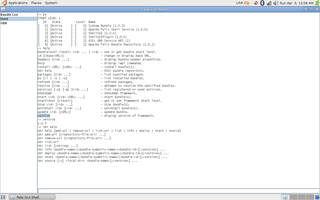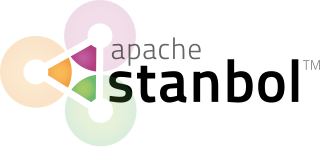Jakarta Server Pages is a collection of technologies that helps software developers create dynamically generated web pages based on HTML, XML, SOAP, or other document types. Released in 1999 by Sun Microsystems, JSP is similar to PHP and ASP, but uses the Java programming language.
The Jakarta Project created and maintained open source software for the Java platform. It operated as an umbrella project under the auspices of the Apache Software Foundation, and all Jakarta products are released under the Apache License. As of December 21, 2011 the Jakarta project was retired because no subprojects were remaining.
A web container is the component of a web server that interacts with Jakarta Servlets. A web container is responsible for managing the lifecycle of servlets, mapping a URL to a particular servlet and ensuring that the URL requester has the correct access-rights. A web container handles requests to servlets, Jakarta Server Pages (JSP) files, and other types of files that include server-side code. The Web container creates servlet instances, loads and unloads servlets, creates and manages request and response objects, and performs other servlet-management tasks. A web container implements the web component contract of the Jakarta EE architecture. This architecture specifies a runtime environment for additional web components, including security, concurrency, lifecycle management, transaction, deployment, and other services.

Apache Tomcat is a free and open-source implementation of the Jakarta Servlet, Jakarta Expression Language, and WebSocket technologies. It provides a "pure Java" HTTP web server environment in which Java code can also run. Thus it is a Java web application server, although not a full JEE application server.

A web application is application software that is accessed using a web browser. Web applications are delivered on the World Wide Web to users with an active network connection.
Jakarta Faces, formerly Jakarta Server Faces and JavaServer Faces (JSF) is a Java specification for building component-based user interfaces for web applications. It was formalized as a standard through the Java Community Process as part of the Java Platform, Enterprise Edition. It is an MVC web framework that simplifies the construction of user interfaces (UI) for server-based applications by using reusable UI components in a page.

Apache Struts 1 is an open-source web application framework for developing Java EE web applications. It uses and extends the Java Servlet API to encourage developers to adopt a model–view–controller (MVC) architecture. It was originally created by Craig McClanahan and donated to the Apache Foundation in May 2000. Formerly located under the Apache Jakarta Project and known as Jakarta Struts, it became a top-level Apache project in 2005.

JSP Model 2 is a complex design pattern used in the design of Java Web applications which separates the display of content from the logic used to obtain and manipulate the content. Since Model 2 drives a separation between logic and display, it is usually associated with the model–view–controller (MVC) paradigm. While the exact form of the MVC "Model" was never specified by the Model 2 design, a number of publications recommend a formalized layer to contain MVC Model code. The Java BluePrints, for example, originally recommended using EJBs to encapsulate the MVC Model.
Apache Jackrabbit is an open source content repository for the Java platform. The Jackrabbit project was started on August 28, 2004, when Day Software licensed an initial implementation of the Java Content Repository API (JCR). Jackrabbit was also used as the reference implementation of JSR-170, specified within the Java Community Process. The project graduated from the Apache Incubator on March 15, 2006, and is now a Top Level Project of the Apache Software Foundation.
Eclipse Jetty is a Java web server and Java Servlet container. While web servers are usually associated with serving documents to people, Jetty is now often used for machine to machine communications, usually within larger software frameworks. Jetty is developed as a free and open source project as part of the Eclipse Foundation. The web server is used in products such as Apache ActiveMQ, Alfresco, Scalatra, Apache Geronimo, Apache Maven, Apache Spark, Google App Engine, Eclipse, FUSE, iDempiere, Twitter's Streaming API and Zimbra. Jetty is also the server in open source projects such as Lift, Eucalyptus, OpenNMS, Red5, Hadoop and I2P. Jetty supports the latest Java Servlet API as well as protocols HTTP/2 and WebSocket.

Apache Felix is an open source implementation of the OSGi Core Release 6 framework specification. The initial codebase was donated from the Oscar project at ObjectWeb. The developers worked on Felix for a full year and have made various improvements while retaining the original footprint and performance. On June 21, 2007, the project graduated from incubation as a top level project and is considered the smallest size software at Apache Software Foundation.
Apache CXF is an open source software project developing a Web services framework. It originated as the combination of Celtix developed by IONA Technologies and XFire developed by a team hosted at Codehaus in 2006. These two projects were combined at the Apache Software Foundation. The name "CXF" was derived by combining "Celtix" and "XFire".
The front controller software design pattern is listed in several pattern catalogs and is related to the design of web applications. It is "a controller that handles all requests for a website," which is a useful structure for web application developers to achieve flexibility and reuse without code redundancy.
Apache Click is a page and component oriented web application framework for the Java language and is built on top of the Java Servlet API.
Java view technologies and frameworks are web-based software libraries that provide the user interface, or "view-layer", of Java web applications. Such application frameworks are used for defining web pages and handling the HTTP requests (clicks) generated by those web pages. As a sub-category of web frameworks, view-layer frameworks often overlap to varying degrees with web frameworks that provide other functionality for Java web applications.
Jakarta RESTful Web Services, is a Jakarta EE API specification that provides support in creating web services according to the Representational State Transfer (REST) architectural pattern. JAX-RS uses annotations, introduced in Java SE 5, to simplify the development and deployment of web service clients and endpoints.
Virgo is an open source, OSGi-based, Java application server. Virgo supports the deployment of OSGi bundles and unmodified Java web applications as well as OSGi-influenced Shared Libraries WARs and Shared Services WARs.

Apache Stanbol is an open source modular software stack and reusable set of components for semantic content management. Apache Stanbol components are meant to be accessed over RESTful interfaces to provide semantic services for content management. Thus, one application is to extend traditional content management systems with semantic services.
Express.js, or simply Express, is a back end web application framework for building RESTful APIs with Node.js, released as free and open-source software under the MIT License. It is designed for building web applications and APIs. It has been called the de facto standard server framework for Node.js.






